The Impact of Opioid Use on Life Expectancy in the Canadian Population
VerifiedAdded on 2022/10/19
|7
|1585
|10
Report
AI Summary
This report investigates the significant health loss associated with opioid use in Canada, highlighting the rise in mortality and disability between 1990 and 2014. It discusses the historical context of opioid prescriptions, the escalation of the public health crisis, and the role of fentanyl in the illicit market. The analysis includes data on opioid-related mortality, the limitations of existing surveys, and the disproportionate impact on certain populations, such as men and young adults. The report also examines the link between opioid dependence, incarceration, and the risk of death. It emphasizes the need for coordinated government health measures to mitigate the crisis, prevent unnecessary deaths, and reduce disability. The study uses various sources, including the Global Burden of Disease (GBD) studies and Canadian public health surveillance data, to illustrate the increasing burden of opioid-related harm and the urgent need for intervention. The conclusion emphasizes that the health loss connected with Opioid use in Canada will be more accurately reflected and that the burden of disease linked to Opioid use will not be taken completely account of in these estimates.
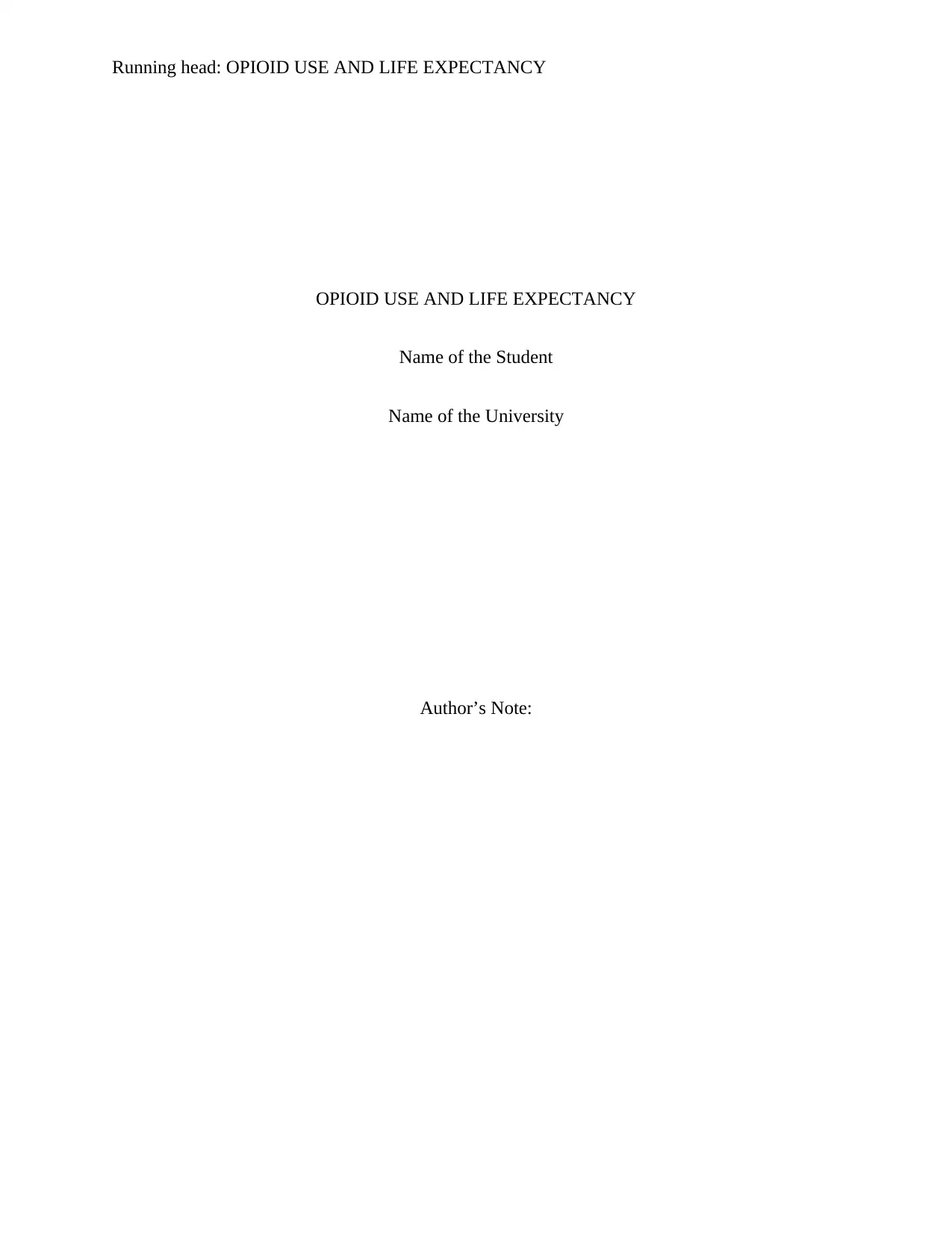
Running head: OPIOID USE AND LIFE EXPECTANCY
OPIOID USE AND LIFE EXPECTANCY
Name of the Student
Name of the University
Author’s Note:
OPIOID USE AND LIFE EXPECTANCY
Name of the Student
Name of the University
Author’s Note:
Paraphrase This Document
Need a fresh take? Get an instant paraphrase of this document with our AI Paraphraser
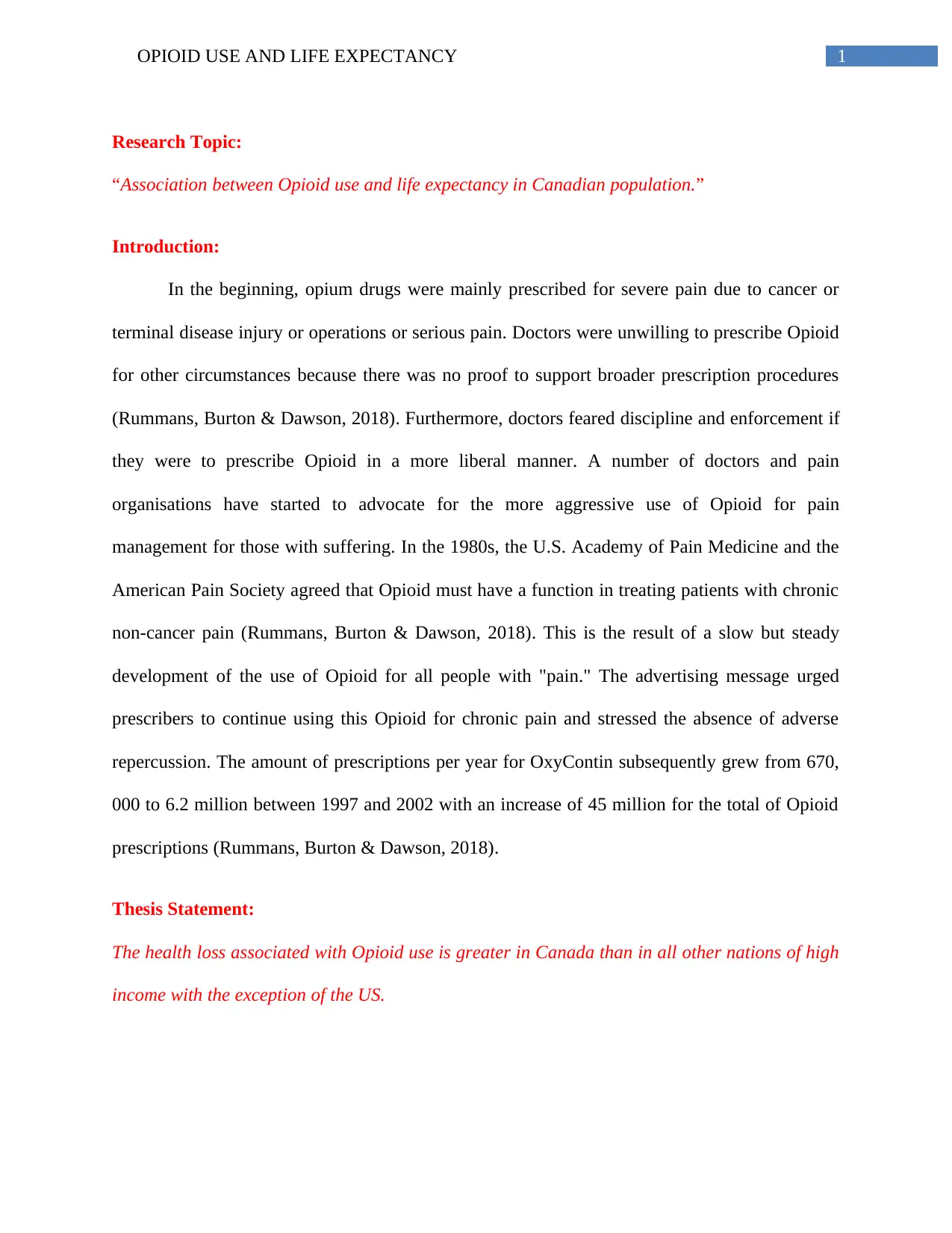
1OPIOID USE AND LIFE EXPECTANCY
Research Topic:
“Association between Opioid use and life expectancy in Canadian population.”
Introduction:
In the beginning, opium drugs were mainly prescribed for severe pain due to cancer or
terminal disease injury or operations or serious pain. Doctors were unwilling to prescribe Opioid
for other circumstances because there was no proof to support broader prescription procedures
(Rummans, Burton & Dawson, 2018). Furthermore, doctors feared discipline and enforcement if
they were to prescribe Opioid in a more liberal manner. A number of doctors and pain
organisations have started to advocate for the more aggressive use of Opioid for pain
management for those with suffering. In the 1980s, the U.S. Academy of Pain Medicine and the
American Pain Society agreed that Opioid must have a function in treating patients with chronic
non-cancer pain (Rummans, Burton & Dawson, 2018). This is the result of a slow but steady
development of the use of Opioid for all people with "pain." The advertising message urged
prescribers to continue using this Opioid for chronic pain and stressed the absence of adverse
repercussion. The amount of prescriptions per year for OxyContin subsequently grew from 670,
000 to 6.2 million between 1997 and 2002 with an increase of 45 million for the total of Opioid
prescriptions (Rummans, Burton & Dawson, 2018).
Thesis Statement:
The health loss associated with Opioid use is greater in Canada than in all other nations of high
income with the exception of the US.
Research Topic:
“Association between Opioid use and life expectancy in Canadian population.”
Introduction:
In the beginning, opium drugs were mainly prescribed for severe pain due to cancer or
terminal disease injury or operations or serious pain. Doctors were unwilling to prescribe Opioid
for other circumstances because there was no proof to support broader prescription procedures
(Rummans, Burton & Dawson, 2018). Furthermore, doctors feared discipline and enforcement if
they were to prescribe Opioid in a more liberal manner. A number of doctors and pain
organisations have started to advocate for the more aggressive use of Opioid for pain
management for those with suffering. In the 1980s, the U.S. Academy of Pain Medicine and the
American Pain Society agreed that Opioid must have a function in treating patients with chronic
non-cancer pain (Rummans, Burton & Dawson, 2018). This is the result of a slow but steady
development of the use of Opioid for all people with "pain." The advertising message urged
prescribers to continue using this Opioid for chronic pain and stressed the absence of adverse
repercussion. The amount of prescriptions per year for OxyContin subsequently grew from 670,
000 to 6.2 million between 1997 and 2002 with an increase of 45 million for the total of Opioid
prescriptions (Rummans, Burton & Dawson, 2018).
Thesis Statement:
The health loss associated with Opioid use is greater in Canada than in all other nations of high
income with the exception of the US.
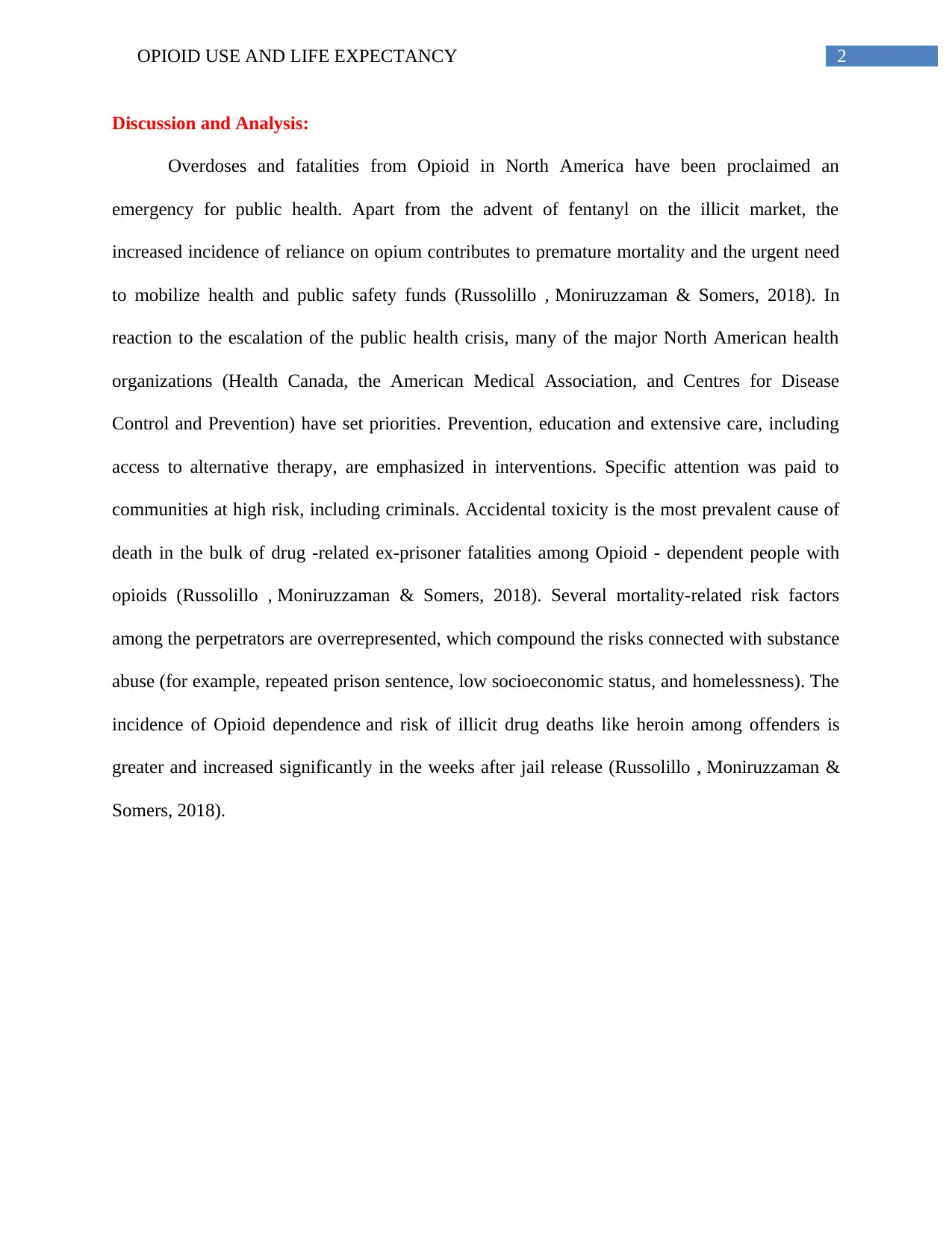
2OPIOID USE AND LIFE EXPECTANCY
Discussion and Analysis:
Overdoses and fatalities from Opioid in North America have been proclaimed an
emergency for public health. Apart from the advent of fentanyl on the illicit market, the
increased incidence of reliance on opium contributes to premature mortality and the urgent need
to mobilize health and public safety funds (Russolillo , Moniruzzaman & Somers, 2018). In
reaction to the escalation of the public health crisis, many of the major North American health
organizations (Health Canada, the American Medical Association, and Centres for Disease
Control and Prevention) have set priorities. Prevention, education and extensive care, including
access to alternative therapy, are emphasized in interventions. Specific attention was paid to
communities at high risk, including criminals. Accidental toxicity is the most prevalent cause of
death in the bulk of drug -related ex-prisoner fatalities among Opioid - dependent people with
opioids (Russolillo , Moniruzzaman & Somers, 2018). Several mortality-related risk factors
among the perpetrators are overrepresented, which compound the risks connected with substance
abuse (for example, repeated prison sentence, low socioeconomic status, and homelessness). The
incidence of Opioid dependence and risk of illicit drug deaths like heroin among offenders is
greater and increased significantly in the weeks after jail release (Russolillo , Moniruzzaman &
Somers, 2018).
Discussion and Analysis:
Overdoses and fatalities from Opioid in North America have been proclaimed an
emergency for public health. Apart from the advent of fentanyl on the illicit market, the
increased incidence of reliance on opium contributes to premature mortality and the urgent need
to mobilize health and public safety funds (Russolillo , Moniruzzaman & Somers, 2018). In
reaction to the escalation of the public health crisis, many of the major North American health
organizations (Health Canada, the American Medical Association, and Centres for Disease
Control and Prevention) have set priorities. Prevention, education and extensive care, including
access to alternative therapy, are emphasized in interventions. Specific attention was paid to
communities at high risk, including criminals. Accidental toxicity is the most prevalent cause of
death in the bulk of drug -related ex-prisoner fatalities among Opioid - dependent people with
opioids (Russolillo , Moniruzzaman & Somers, 2018). Several mortality-related risk factors
among the perpetrators are overrepresented, which compound the risks connected with substance
abuse (for example, repeated prison sentence, low socioeconomic status, and homelessness). The
incidence of Opioid dependence and risk of illicit drug deaths like heroin among offenders is
greater and increased significantly in the weeks after jail release (Russolillo , Moniruzzaman &
Somers, 2018).
⊘ This is a preview!⊘
Do you want full access?
Subscribe today to unlock all pages.

Trusted by 1+ million students worldwide
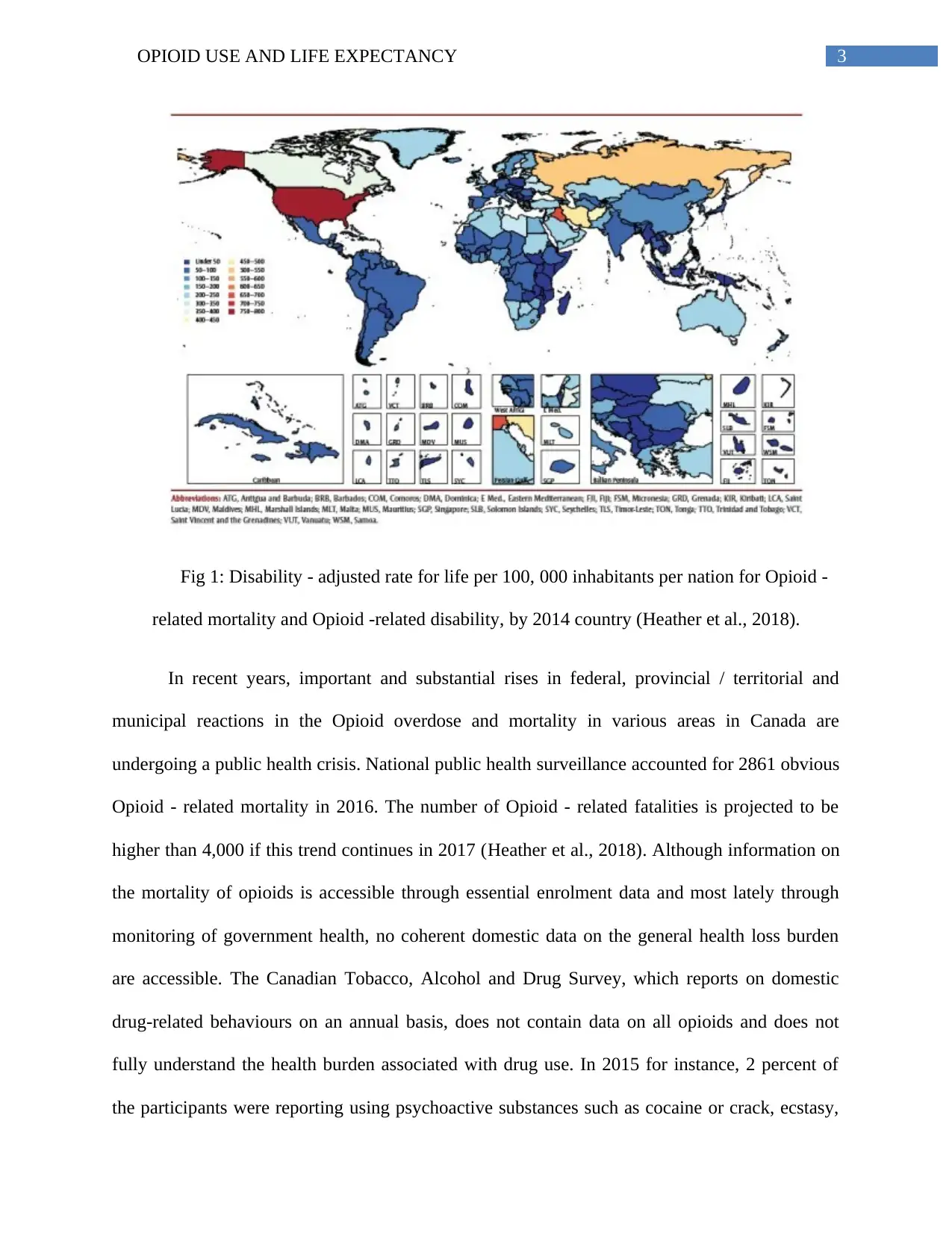
3OPIOID USE AND LIFE EXPECTANCY
Fig 1: Disability - adjusted rate for life per 100, 000 inhabitants per nation for Opioid -
related mortality and Opioid -related disability, by 2014 country (Heather et al., 2018).
In recent years, important and substantial rises in federal, provincial / territorial and
municipal reactions in the Opioid overdose and mortality in various areas in Canada are
undergoing a public health crisis. National public health surveillance accounted for 2861 obvious
Opioid - related mortality in 2016. The number of Opioid - related fatalities is projected to be
higher than 4,000 if this trend continues in 2017 (Heather et al., 2018). Although information on
the mortality of opioids is accessible through essential enrolment data and most lately through
monitoring of government health, no coherent domestic data on the general health loss burden
are accessible. The Canadian Tobacco, Alcohol and Drug Survey, which reports on domestic
drug-related behaviours on an annual basis, does not contain data on all opioids and does not
fully understand the health burden associated with drug use. In 2015 for instance, 2 percent of
the participants were reporting using psychoactive substances such as cocaine or crack, ecstasy,
Fig 1: Disability - adjusted rate for life per 100, 000 inhabitants per nation for Opioid -
related mortality and Opioid -related disability, by 2014 country (Heather et al., 2018).
In recent years, important and substantial rises in federal, provincial / territorial and
municipal reactions in the Opioid overdose and mortality in various areas in Canada are
undergoing a public health crisis. National public health surveillance accounted for 2861 obvious
Opioid - related mortality in 2016. The number of Opioid - related fatalities is projected to be
higher than 4,000 if this trend continues in 2017 (Heather et al., 2018). Although information on
the mortality of opioids is accessible through essential enrolment data and most lately through
monitoring of government health, no coherent domestic data on the general health loss burden
are accessible. The Canadian Tobacco, Alcohol and Drug Survey, which reports on domestic
drug-related behaviours on an annual basis, does not contain data on all opioids and does not
fully understand the health burden associated with drug use. In 2015 for instance, 2 percent of
the participants were reporting using psychoactive substances such as cocaine or crack, ecstasy,
Paraphrase This Document
Need a fresh take? Get an instant paraphrase of this document with our AI Paraphraser
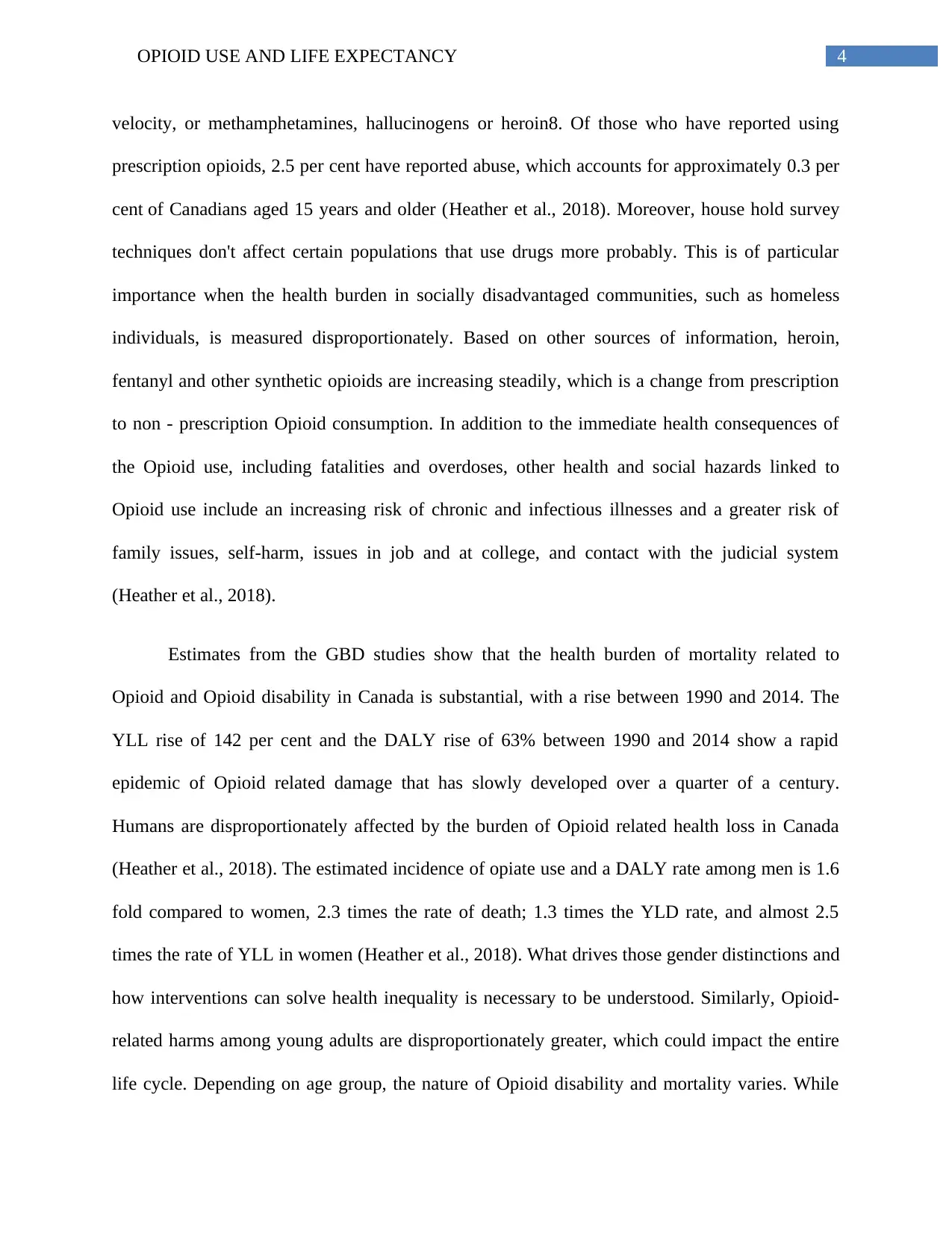
4OPIOID USE AND LIFE EXPECTANCY
velocity, or methamphetamines, hallucinogens or heroin8. Of those who have reported using
prescription opioids, 2.5 per cent have reported abuse, which accounts for approximately 0.3 per
cent of Canadians aged 15 years and older (Heather et al., 2018). Moreover, house hold survey
techniques don't affect certain populations that use drugs more probably. This is of particular
importance when the health burden in socially disadvantaged communities, such as homeless
individuals, is measured disproportionately. Based on other sources of information, heroin,
fentanyl and other synthetic opioids are increasing steadily, which is a change from prescription
to non - prescription Opioid consumption. In addition to the immediate health consequences of
the Opioid use, including fatalities and overdoses, other health and social hazards linked to
Opioid use include an increasing risk of chronic and infectious illnesses and a greater risk of
family issues, self-harm, issues in job and at college, and contact with the judicial system
(Heather et al., 2018).
Estimates from the GBD studies show that the health burden of mortality related to
Opioid and Opioid disability in Canada is substantial, with a rise between 1990 and 2014. The
YLL rise of 142 per cent and the DALY rise of 63% between 1990 and 2014 show a rapid
epidemic of Opioid related damage that has slowly developed over a quarter of a century.
Humans are disproportionately affected by the burden of Opioid related health loss in Canada
(Heather et al., 2018). The estimated incidence of opiate use and a DALY rate among men is 1.6
fold compared to women, 2.3 times the rate of death; 1.3 times the YLD rate, and almost 2.5
times the rate of YLL in women (Heather et al., 2018). What drives those gender distinctions and
how interventions can solve health inequality is necessary to be understood. Similarly, Opioid-
related harms among young adults are disproportionately greater, which could impact the entire
life cycle. Depending on age group, the nature of Opioid disability and mortality varies. While
velocity, or methamphetamines, hallucinogens or heroin8. Of those who have reported using
prescription opioids, 2.5 per cent have reported abuse, which accounts for approximately 0.3 per
cent of Canadians aged 15 years and older (Heather et al., 2018). Moreover, house hold survey
techniques don't affect certain populations that use drugs more probably. This is of particular
importance when the health burden in socially disadvantaged communities, such as homeless
individuals, is measured disproportionately. Based on other sources of information, heroin,
fentanyl and other synthetic opioids are increasing steadily, which is a change from prescription
to non - prescription Opioid consumption. In addition to the immediate health consequences of
the Opioid use, including fatalities and overdoses, other health and social hazards linked to
Opioid use include an increasing risk of chronic and infectious illnesses and a greater risk of
family issues, self-harm, issues in job and at college, and contact with the judicial system
(Heather et al., 2018).
Estimates from the GBD studies show that the health burden of mortality related to
Opioid and Opioid disability in Canada is substantial, with a rise between 1990 and 2014. The
YLL rise of 142 per cent and the DALY rise of 63% between 1990 and 2014 show a rapid
epidemic of Opioid related damage that has slowly developed over a quarter of a century.
Humans are disproportionately affected by the burden of Opioid related health loss in Canada
(Heather et al., 2018). The estimated incidence of opiate use and a DALY rate among men is 1.6
fold compared to women, 2.3 times the rate of death; 1.3 times the YLD rate, and almost 2.5
times the rate of YLL in women (Heather et al., 2018). What drives those gender distinctions and
how interventions can solve health inequality is necessary to be understood. Similarly, Opioid-
related harms among young adults are disproportionately greater, which could impact the entire
life cycle. Depending on age group, the nature of Opioid disability and mortality varies. While
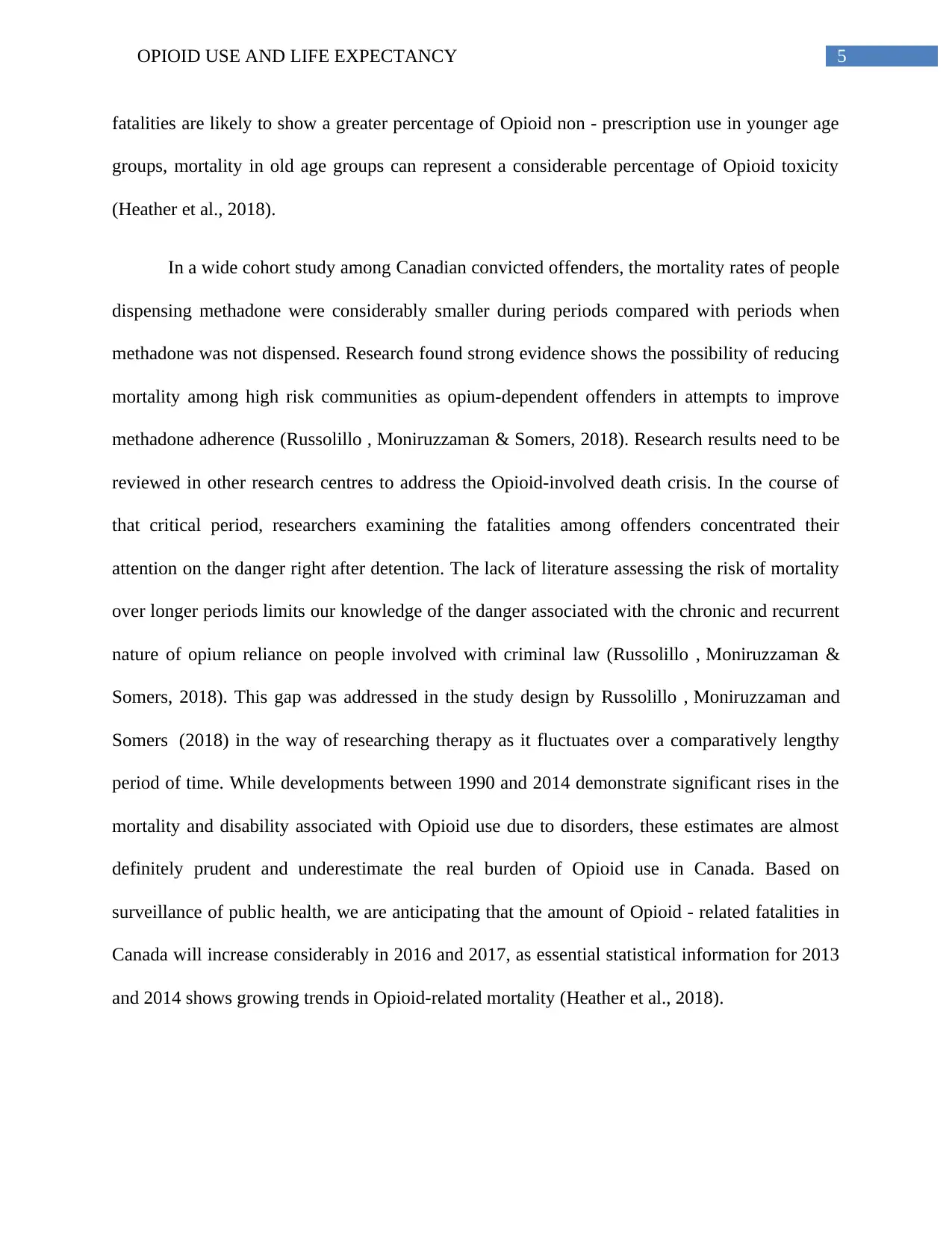
5OPIOID USE AND LIFE EXPECTANCY
fatalities are likely to show a greater percentage of Opioid non - prescription use in younger age
groups, mortality in old age groups can represent a considerable percentage of Opioid toxicity
(Heather et al., 2018).
In a wide cohort study among Canadian convicted offenders, the mortality rates of people
dispensing methadone were considerably smaller during periods compared with periods when
methadone was not dispensed. Research found strong evidence shows the possibility of reducing
mortality among high risk communities as opium-dependent offenders in attempts to improve
methadone adherence (Russolillo , Moniruzzaman & Somers, 2018). Research results need to be
reviewed in other research centres to address the Opioid-involved death crisis. In the course of
that critical period, researchers examining the fatalities among offenders concentrated their
attention on the danger right after detention. The lack of literature assessing the risk of mortality
over longer periods limits our knowledge of the danger associated with the chronic and recurrent
nature of opium reliance on people involved with criminal law (Russolillo , Moniruzzaman &
Somers, 2018). This gap was addressed in the study design by Russolillo , Moniruzzaman and
Somers (2018) in the way of researching therapy as it fluctuates over a comparatively lengthy
period of time. While developments between 1990 and 2014 demonstrate significant rises in the
mortality and disability associated with Opioid use due to disorders, these estimates are almost
definitely prudent and underestimate the real burden of Opioid use in Canada. Based on
surveillance of public health, we are anticipating that the amount of Opioid - related fatalities in
Canada will increase considerably in 2016 and 2017, as essential statistical information for 2013
and 2014 shows growing trends in Opioid-related mortality (Heather et al., 2018).
fatalities are likely to show a greater percentage of Opioid non - prescription use in younger age
groups, mortality in old age groups can represent a considerable percentage of Opioid toxicity
(Heather et al., 2018).
In a wide cohort study among Canadian convicted offenders, the mortality rates of people
dispensing methadone were considerably smaller during periods compared with periods when
methadone was not dispensed. Research found strong evidence shows the possibility of reducing
mortality among high risk communities as opium-dependent offenders in attempts to improve
methadone adherence (Russolillo , Moniruzzaman & Somers, 2018). Research results need to be
reviewed in other research centres to address the Opioid-involved death crisis. In the course of
that critical period, researchers examining the fatalities among offenders concentrated their
attention on the danger right after detention. The lack of literature assessing the risk of mortality
over longer periods limits our knowledge of the danger associated with the chronic and recurrent
nature of opium reliance on people involved with criminal law (Russolillo , Moniruzzaman &
Somers, 2018). This gap was addressed in the study design by Russolillo , Moniruzzaman and
Somers (2018) in the way of researching therapy as it fluctuates over a comparatively lengthy
period of time. While developments between 1990 and 2014 demonstrate significant rises in the
mortality and disability associated with Opioid use due to disorders, these estimates are almost
definitely prudent and underestimate the real burden of Opioid use in Canada. Based on
surveillance of public health, we are anticipating that the amount of Opioid - related fatalities in
Canada will increase considerably in 2016 and 2017, as essential statistical information for 2013
and 2014 shows growing trends in Opioid-related mortality (Heather et al., 2018).
⊘ This is a preview!⊘
Do you want full access?
Subscribe today to unlock all pages.

Trusted by 1+ million students worldwide
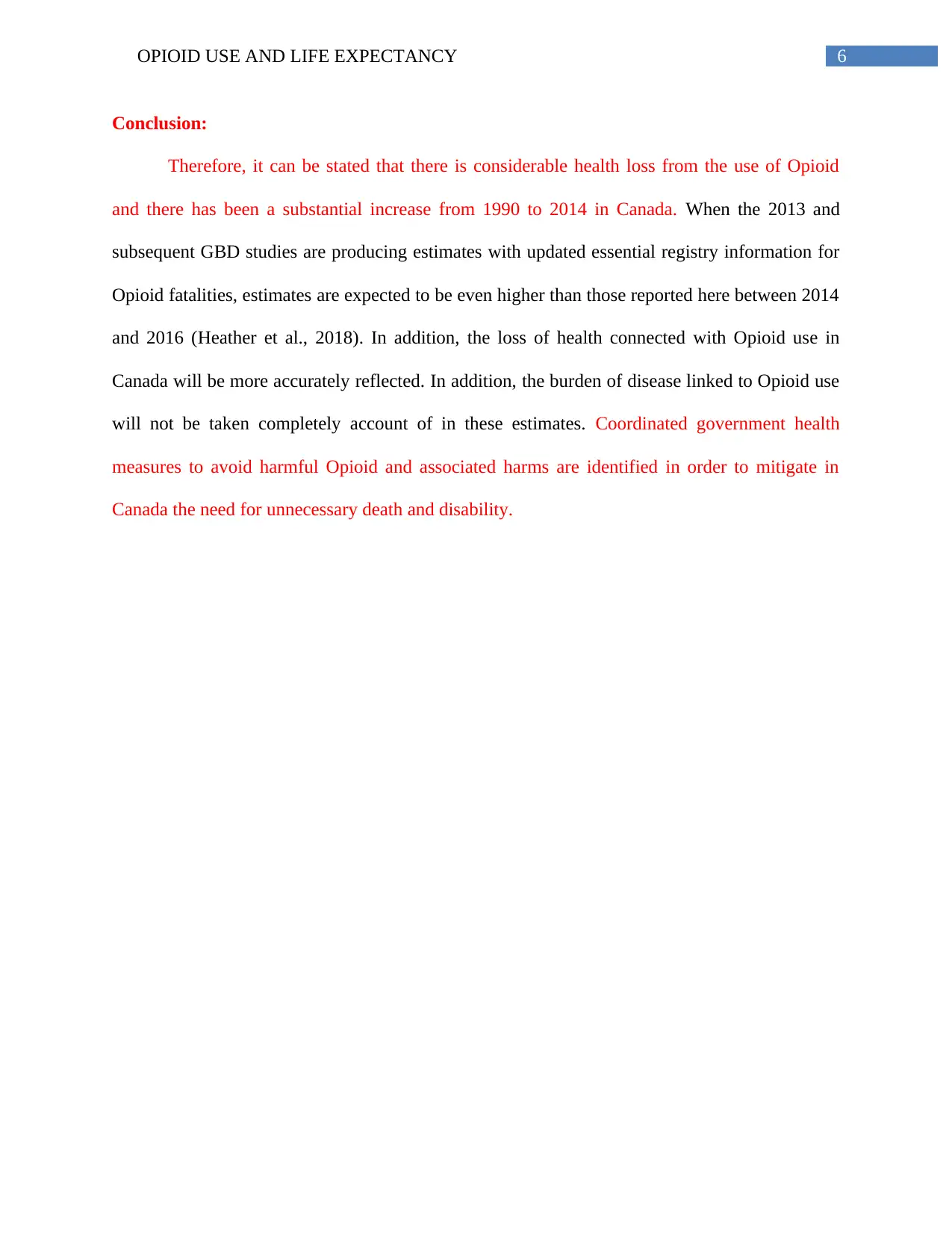
6OPIOID USE AND LIFE EXPECTANCY
Conclusion:
Therefore, it can be stated that there is considerable health loss from the use of Opioid
and there has been a substantial increase from 1990 to 2014 in Canada. When the 2013 and
subsequent GBD studies are producing estimates with updated essential registry information for
Opioid fatalities, estimates are expected to be even higher than those reported here between 2014
and 2016 (Heather et al., 2018). In addition, the loss of health connected with Opioid use in
Canada will be more accurately reflected. In addition, the burden of disease linked to Opioid use
will not be taken completely account of in these estimates. Coordinated government health
measures to avoid harmful Opioid and associated harms are identified in order to mitigate in
Canada the need for unnecessary death and disability.
Conclusion:
Therefore, it can be stated that there is considerable health loss from the use of Opioid
and there has been a substantial increase from 1990 to 2014 in Canada. When the 2013 and
subsequent GBD studies are producing estimates with updated essential registry information for
Opioid fatalities, estimates are expected to be even higher than those reported here between 2014
and 2016 (Heather et al., 2018). In addition, the loss of health connected with Opioid use in
Canada will be more accurately reflected. In addition, the burden of disease linked to Opioid use
will not be taken completely account of in these estimates. Coordinated government health
measures to avoid harmful Opioid and associated harms are identified in order to mitigate in
Canada the need for unnecessary death and disability.
1 out of 7
Your All-in-One AI-Powered Toolkit for Academic Success.
+13062052269
info@desklib.com
Available 24*7 on WhatsApp / Email
![[object Object]](/_next/static/media/star-bottom.7253800d.svg)
Unlock your academic potential
Copyright © 2020–2025 A2Z Services. All Rights Reserved. Developed and managed by ZUCOL.